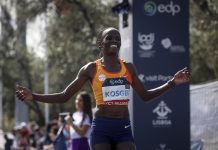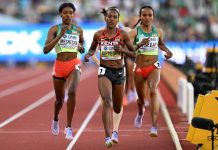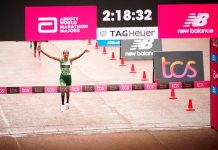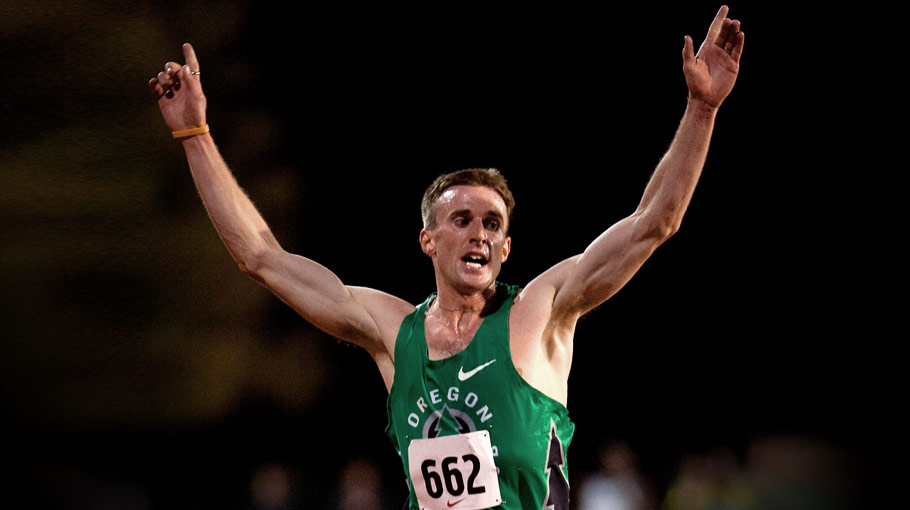By Bryan Green
Chris Solinsky made the most memorable leap of 2010. In the world of distance running, every year is a leap year. For a few people at least.
One way we can define a year is by who made “the leap.” For example, if you ask me about 2007, I immediately think of Alan Webb and Ryan Hall making the leap that year. The leap is not a great race. It is not improved consistency or even an undefeated record. But it’s not just a bunch of PRs, either. It’s a significant improvement that results in a combination of dominance, consistency, and performances that surpass previous expectations.
Here are the four key factors that define “the leap” in track and field terms:
The athlete’s improvement does not appear to be incremental; a big improvement happens suddenly (to the outside observer)
The athlete dominates competitors who were previously equals; there is a notable shift of power at their current level (high school, NCAA, juniors, etc)
The improvement is sustained, as evidenced by improved consistency and numerous performances over time
For levels below the world elite, the athlete’s performances are equivalent to top athletes at the next level and/or GOAT status for their current level
Kenenisa Bekele illustrates well what is and is not a leap. Bekele is undefeated at 10,000 meters. Since 2003 he has won four World Championships and two Olympics, and set two world records at the distance. But in that time he’s only made one “leap,” and that was in 2004. That year he went from a 26:49/12:52 guy to a 26:20/12:37 guy. That is, he went from world class to fastest of all-time. Since then, he’s simply maintained his status at the top.
Now, that’s not to say an athlete can’t have more than one “leap” in a career. Bekele likely had another “leap” earlier in his career as well. The best example I can think of occurred within the past few years. German Fernandez made one leap during his senior year in high school, where he went from a very promising runner to breaking Jeff Nelson’s two-mile record and running a 4:00/8:34 double. The very next year he made another leap, running 3:55/13:25 as a college freshman and winning the NCAA 1500m title. That’s a back-to-back double leap! It’s no wonder everyone couldn’t stop talking about him.
In both examples, Bekele and Fernandez made apparently big improvements, they dominated their competition, they maintained that level of performance (with the caveat that each has spent some time injured recently), and their performances either put them in the discussion for GOAT (Bekele) or showed clear evidence of an ability to compete at the next level (Fernandez).
So with that said, who were the leapers of 2010, and who seems poised to make the leap this year? I’m going to focus on the US athletes who made the leap, but the sidebar below lists some other individuals who I believe qualify.
Looking Back at 2010
Other Leapers in the Previous Five Years
2010
Robert K Cheruiyot
Gebre Gebremariam
Liliya Shobukhova
Mo Farah
Silas Kiplagat
Ryan Gregson
David Rudisha
2009
Sammy Kitwara
Collis Birmingham
Dathan Ritzenhein
Jenny Simpson (Barringer)
Anna Pierce
Christin Wurth-Thomas
German Fernandez
2008
Asbel Kiprop
Tirunesh Dibaba
Shannon Rowbury
German Fernandez
Andrew Wheating
2007
Sammy Wanjiru
Patrick Makau
Mary Keitany
Vivian Cheruiyot
Alan Webb
Shalane Flanagan
Kara Goucher
Ryan Hall
2006
Zersenay Tadese
Matt Tegenkamp
(I’m sure I missed a bunch. Feel free to add those I missed in the comments) In the US, I think six athletes stand out as having made “the leap” in 2010. Those athletes are Alysia Johnson, Phoebe Wright, Andrew Wheating, Molly Huddle, Chris Solinsky, and Lisa Koll.
Alysia Johnson (800m) — Johnson wasn’t just the top 800m in the US, but was amongst the very best in the world last year. She went from being a promising athlete battling injuries to an indoor World bronze medallist, the US champ, 5th all-time in the US, she broke 2:00 eight times and ran her three fastest times ever. On top of that, she won three European track meets.
Phoebe Wright (800m) — The knock against including her on this list is that her progression over the past few years has been a little too “steady”. But I don’t think anyone was prepared for the way Wright would dominate the NCAA last year. She not only went undefeated in NCAA competition, but she ran eight of her top ten performances, as well as two sub-2:00 performances. Her 3rd place finish at the USA Outdoors proved she could compete at the next level, too.
Andrew Wheating (800m/1500m) — Wheating made his first “leap” back in 2008, when he shocked everyone by making the US Olympic team. Since that time, he consistently ran times that put him atop the NCAA rankings, but hadn’t really broken through again. That breakthrough happened last year, where he ran 3:30.90 (4th US all-time), a 3:51.74 mile, five of his top ten performances at 800m (including two PRs), and dominated the NCAA at both distances (with the acknowledgement that Robby Andrews did make him sweat a bit at 800m).
Molly Huddle (5000m) — Huddle, the US JR 5000m record holder, spent the past couple years as a talented runner battling injuries and consistency. In 2010 she put it together and rewrote the US 5000m record books (14:44.76, #1 US all-time) in the process. She ran six of her top ten performances at 5000m, as well as won three road races and finished 2nd to Shalane Flanagan at the US Cross Country Championships.
Chris Solinsky (5000m/10000m) — Probably the biggest story of 2010 in the US, the forgotten phenom Chris Solinsky ran his remarkable 26:59 AR for 10000m, as well as his four fastest 5000m performances (three of which were sub-12:57). He even ran personal bests at 3000m and one mile. Like Wheating, he was the model of consistency, with eight outstanding performances in his nine races last year.
Lisa Koll’s leap took her from being a good college runner to a class of her own. Lisa Koll (5000m/10000m) — Perhaps the quintessential leap year, Koll’s 2010 was remarkable. She improved her performances at 5000m (14:55, 7th US all-time) and 10000m (31:18, 6th US all-time, NCAA record) by 64 and 53 seconds, respectively. She dominated the NCAA, winning an indoor 5000m title and the NCAA Outdoor distance double, before finishing 2nd to Amy Begley at 10000m at the US Outdoor championships.
That’s it. That’s where I draw the line. Some honorable mentions (athletes who made “bounds” as opposed to “leaps”?) include Desiree Davila and Magdalena Lewy-Boulet (2:26 marathons), Brett Gotcher (2:10:36 marathon), Leonel Manzano (nothing really changed in terms of his US ranking, he just ran faster), Galen Rupp (same as Manzano), Morgan Uceny (PRs at both 800m and 1500m), and Dan Huling (PRs at 5000m/steeple).
Looking Ahead to 2011
Prediction-making is a losing proposition. Even with the right analysis, so much can happen to make your predictions not come true. With that said, we can make some general observations about “the leap” that will likely hold true.
You can generally expect to see a couple college athletes make the leap
Every couple years a high school athlete makes the leap
Elite athletes who make the leap often do so as a result of extended periods of injury-free training
In the year prior to making the leap, athletes tend to have one or two performances that make you think they might be ready
Based on the above, here are the athletes I’m watching this season:
Robby Andrews’s 2010 has 2011 leap year written all over it. Robby Andrews (800m) — His two victories over Andrew Wheating were the type of performances that harbinger big things in the future. He’s the one guy I’d bet on if money was on the line.
Phoebe Wright (800m) — The one athlete I think has the potential for a “back-to-back double leap.”
Morgan Uceny (800m/1500m) — There’s a great argument to be made for her having made a leap last year. I think the real leap is coming this year.
Dan Huling (steeple) — See Morgan Uceny above.
Jordan Hasay (1500m/5000m) — Two 4:13s at the end of last year and a 3rd place finish at NCAA XC are signs she’s going to have a big spring.
German Fernandez (1500m/5000m) — He’s probably two years away from another leap, but I said that after his senior year in high school, too.
Chris Derrick (5000m/10000m) — I’m really high on Derrick. I think this could be his year, both in track this spring and cross country later this fall.
Amy Begley (5000m/10000m) — She’s a little older, but her last two years have been fantastic. If she’s going to make a leap, I think it’s now or never.
Angela Bizzarri (5000m) — She ended her NCAA career without popping a huge PR, despite winning multiple national titles. She’s due.
I’ll be the first to admit that I don’t follow all the athletes around the world as closely as those in the US, so I’m sure there are quite a number who are poised to have a leap year this year. Who do you think we’ll be talking about this time next year?





























